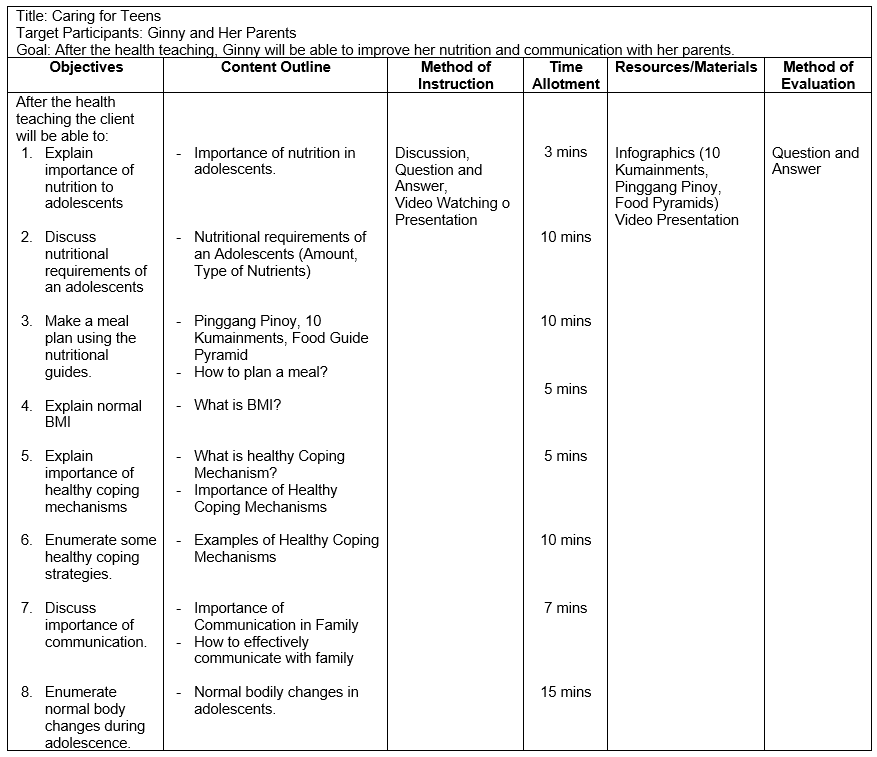|
Problems Identified |
Rationale |
Goals of Care |
Interventions |
|
Imbalance Nutrition: Less than body requirements r/t inadequate knowledge of nutrient requirements aeb being underweight with BMI below the 5th percentile. |
Adolescence is a period of rapid growth hence adequate nutrition is needed to support this growth. In this case, Ginny is not getting enough nutrients to support her growth as seen from her BMI, thus a priority nursing problem because it might lead to other health problems. |
Explain the importance of nutrition. Describe her nutritional requirements according to age and sex Increase her weight to normal according to height, age, and sex. |
Discuss the importance of nutrition for adolescents Teach her about her nutritional requirements, and how to use Filipino nutritional guides. Encourage her and her parents to follow food guides in preparing meals to support weight gain. |
|
Ineffective adolescent eating dynamics r/t inadequate dietary habits aeb verbalization of trying to lose weight even though her BMI is already below the 5th percentile. |
Ineffective eating dynamics in teens is not uncommon and is influenced by several factors. Ginny’s behavior, trying to lose weight despite having a low BMI, possibly indicates lack of knowledge about proper nutrition which means that adequate teaching must be conducted to prevent other health problems. |
Maintain a normal and healthy eating habits. Attain and maintain a normal BMI. |
Discuss normal BMI. Encourage her to adhere to healthy eating patterns to achieve a normal BMI. |
|
Stress overload r/t stressors aeb verbalization of feeling stressed (keeping her grades up). |
Stress is another priority nursing problem because it is the root cause of other health problems. This problem is supported by her verbalization of being stressed keeping her grades high for college. |
Perform healthy coping mechanisms.
|
Teach about healthy coping mechanisms. Motivate her to use healthy coping mechanisms. Encourage her to communicate this concern with her parents and look for support system. |
|
Interrupted family process r/t altered family interaction aeb mother’s verbalization of altered communication patterns (having a hard time talking with Ginny). |
Positive family communication influences the decision making of most adolescents. It increases healthy behaviors and lessen the risky behaviors (Alberti, et al., 2018). Thus, ineffective communication in family must be resolved in order to prevent adherence to adolescents to risky behaviors. |
Perform effective communication |
Discuss importance of communication in family and how to perform effective communication within family. |
|
Risk for situational low self-esteem r/t inadequate family cohesiveness and disturbed body image (acne breakout on face and neck, trying to lose weight even with low BMI). |
Low self-esteem is common among adolescent; however, it can still lead to various health problems hence, interventions must be done. In Ginny’s case, the risk for low self-esteem can be related to the bodily changes that occurs in adolescents and the inadequate family cohesiveness brought by ineffective family communication. |
Explain the normal changes that occur during adolescence.
Improve her self-awareness and self-esteem. |
Discuss normal changes in adolescents’ body. Use active listening. Support her explore her strengths and weaknesses to improve self-awareness and self-esteem. Teach her the harmful effects of negative thoughts on self. Discuss importance of family support in developing her self-esteem. Encourage her to join groups/activities that promote self-esteem. |
|
Anticipated Problems |
Rationale |
|
Anxiety r/t stressors aeb anorexia, verbalization of being stress, and changes in her body (acne breakout). |
This problem might arise from being stress over her grades and her consciousness over the scars (acne breakout). |
|
Disturbed body image r/t body consciousness aeb trying to lose weight, and monitor’s changes in one’s body. |
Ginny might be experiencing disturbed body image but further assessment must be done to establish this problem. |
|
Readiness for enhance family process aeb verbalization of desire to enhance communication between family members |
Ginny and her mother might verbalize the desire to enhance their family interaction (communication). |
References:
ACT for Youth Center of Excellence. (2003). Adolescents self-esteem. Retrieved from https://www.actforyouth.net/resources/rf/rf_slfestm_0603.cfm#:~:text=The%20results%20of%20low%20self,to%20school%20performance%20and%20delinquency.
Alberti, T. L., Benes, S., & Miles, D. (2018). Experiences of health communication within the family: Parent-adolescent perspectives. Journal of adolescent and family health, 9(1). Retrieved from https://scholar.utc.edu/cgi/viewcontent.cgi?article=1069&context=jafh
Aldaba, J. (2022). Care of the child from infancy to adolescence: Care of the adolescent. [PowerPoint]. University of the Philippines Manila Virtual learning Environment:
Bulechek, G.M., Butcher, H.K., Dochterman, J.M., & Wagner, C. (2013). Nursing Interventions Classification (NIC) (6th ed.). Mosby
Herdman, T. H., Kamitsuru, S., & Lopes, C. T. (2021). Nursing diagnoses definitions and classifications 2021-2023 (12th ed.). NANDA International.
Moorhead, S., Johnson, M., Maas, M.L., & Swanson, E. (2013). Nursing Outcomes Classification (NOC). Mosby Inc.
Pillitteri, A. (2014). Maternal & child health nursing: Care of the childbearing and childrearing family. (7th ed.) Lippincott Williams and Wilkins.
